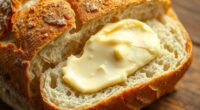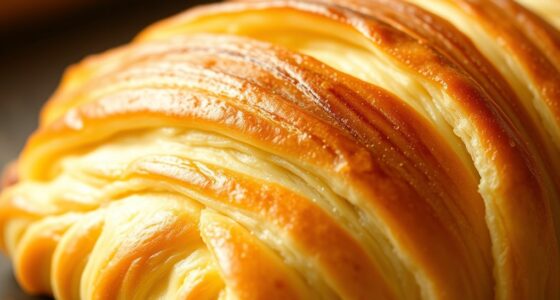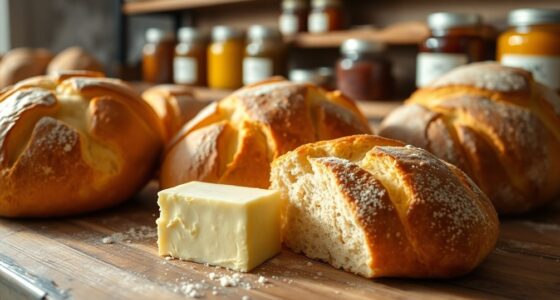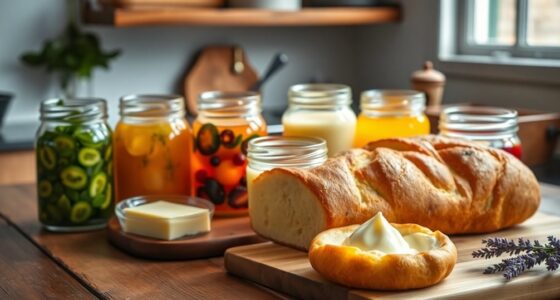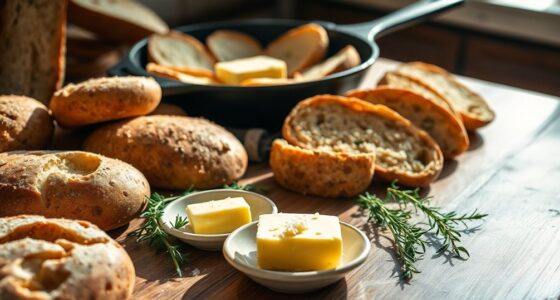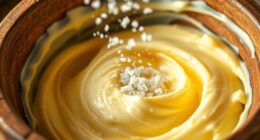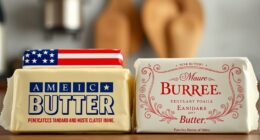Choosing between sweet and cultured butter for cinnamon rolls impacts flavor and texture. Sweet butter offers a milder, creamier taste that highlights cinnamon and sugar, while cultured butter develops a tangy, complex flavor that adds depth. The type you select also influences dough tenderness, layering, and melting speed. For a nuanced, richer result, cultured butter is ideal; for a light, fresh taste, go with sweet butter. Discover more ways to elevate your cinnamon rolls as you continue.
Key Takeaways
- Sweet butter offers a mild, creamy flavor that highlights cinnamon and sugar, ideal for lighter, delicate rolls.
- Cultured butter adds tangy, complex notes that deepen flavor and elevate rich, yeasted cinnamon roll doughs.
- The choice influences dough texture and layering; cultured butter promotes flakiness, while sweet butter yields a softer crumb.
- Sweet butter melts quickly, creating a smooth, mellow glaze; cultured butter’s acidity enhances depth and a tangy finish.
- Both types vary in health benefits; cultured butter may support gut health with probiotics, while sweet butter is fresher with fewer bacteria.
Characteristics of Sweet Butter and Its Impact on Flavor
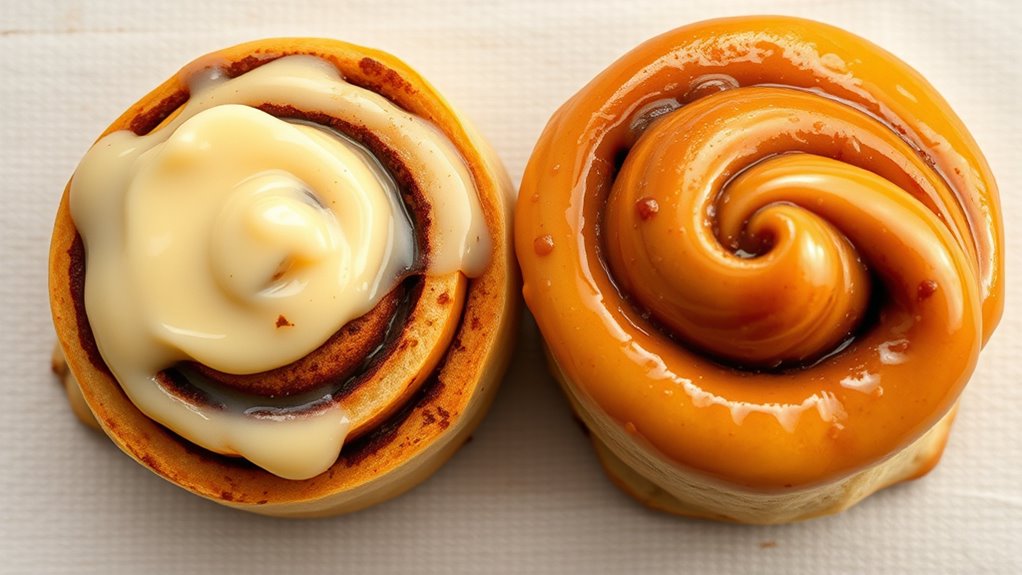
Sweet butter typically has a higher sugar content and a creamier texture than cultured butter, which substantially influences the flavor of cinnamon rolls. When storing butter, you want to keep it in a cool, airtight environment to preserve its sweetness and consistency. Butter branding also plays a role; premium brands often use fresh cream, enhancing sweetness and richness. This higher sugar content gives your cinnamon rolls a delicate sweetness and a velvety mouthfeel. Because sweet butter is less tangy than cultured varieties, it produces a milder, more straightforward flavor. Proper butter storage prevents spoilage, ensuring the sugar and fats stay fresh, while choosing reputable butter branding guarantees quality. Additionally, understanding the composition of different butter types helps in selecting the best option for baking. This combination results in a softer, sweeter, and more indulgent cinnamon roll experience.
The Distinctive Traits of Cultured Butter in Baking

Cultured butter stands out in baking due to its tangy flavor and complex aroma, which result from the fermentation process it undergoes. This butter is made through butter fermentation, where beneficial bacteria develop during aging, enhancing its dairy origin. The fermentation process creates a distinctive acidity that adds depth to baked goods, especially in cinnamon rolls. Its rich, slightly tangy profile can brighten the overall flavor, balancing sweetness and spice. Unlike sweet butter, cultured butter’s dairy origin provides a more pronounced, nuanced taste that can elevate your baking. This unique profile makes it a favorite for bakers seeking a complex flavor layer, as the fermentation imparts a subtle tang that complements the warm spices and sweet fillings in cinnamon rolls. Additionally, the preppy dog names concept emphasizes a refined and sophisticated aesthetic, much like the elevated flavor profile of cultured butter.
Texture Differences: How Butter Type Affects Cinnamon Roll Dough

The type of butter you choose directly impacts how your dough spreads, feels, and holds together. Cultured butter tends to create a softer, more elastic dough, while sweet butter can add flakiness and distinct layering. Understanding these texture differences helps you perfect the perfect cinnamon roll every time. Additionally, color accuracy in the ingredients can influence the visual appeal of your final baked good, making it look as appetizing as it tastes.
Spreadability and Softness
Choosing the right butter can substantially impact how your cinnamon roll dough feels and behaves. Spreadability and softness are key factors influenced by butter type. Sweet butter often has a smoother, creamier texture that mixes easily, resulting in a dough that’s soft and easy to work with. Cultured butter, with its more complex flavor, can be slightly firmer, affecting how it blends into your mixture. When selecting butter, consider its branding and packaging design—some brands emphasize creaminess and spreadability, making your baking smoother. Additionally, understanding creative practice can help you experiment with different butter types to discover your perfect cinnamon roll texture.
Dough Elasticity and Structure
Butter type considerably influences how your cinnamon roll dough comes together, especially in terms of elasticity and structure. Sweet butter, often stored in smaller, airtight packaging, tends to be softer and more pliable, which can result in a dough that’s easier to stretch and shape. Cultured butter, usually stored in larger blocks, has a firmer texture that provides more resistance, leading to a sturdier dough with better elasticity. Proper butter storage affects how the fat integrates into the dough; cold, well-wrapped butter helps maintain its structure, ensuring even distribution. This influences the dough’s ability to hold its shape during kneading and rising, ultimately shaping the final texture of your cinnamon rolls. The choice of butter and its packaging directly impacts how well your dough develops its elasticity and overall structure. Temperature control during mixing and resting also plays a crucial role in achieving optimal dough elasticity and consistency.
Flakiness and Layering
Since butter’s fat content and temperature influence how the dough layers during baking, the type you use directly affects cinnamon roll flakiness. Cultured butter often has a richer butter color and higher nutritional content, which can enhance the visual appeal and flavor complexity. Sweet butter, typically milder in color, melts differently, impacting layering and flakiness. When baking, consider these factors:
- Cultured butter’s acidity can strengthen gluten, creating more distinct, flaky layers.
- Higher fat content in cultured butter promotes tender, crisp edges.
- The butter’s color and nutritional profile subtly influence dough handling and final texture.
Choosing between sweet and cultured butter ultimately alters the dough’s ability to form those delicate, flaky layers you crave in a perfect cinnamon roll.
Flavor Profiles: Sweet Butter Versus Cultured Butter
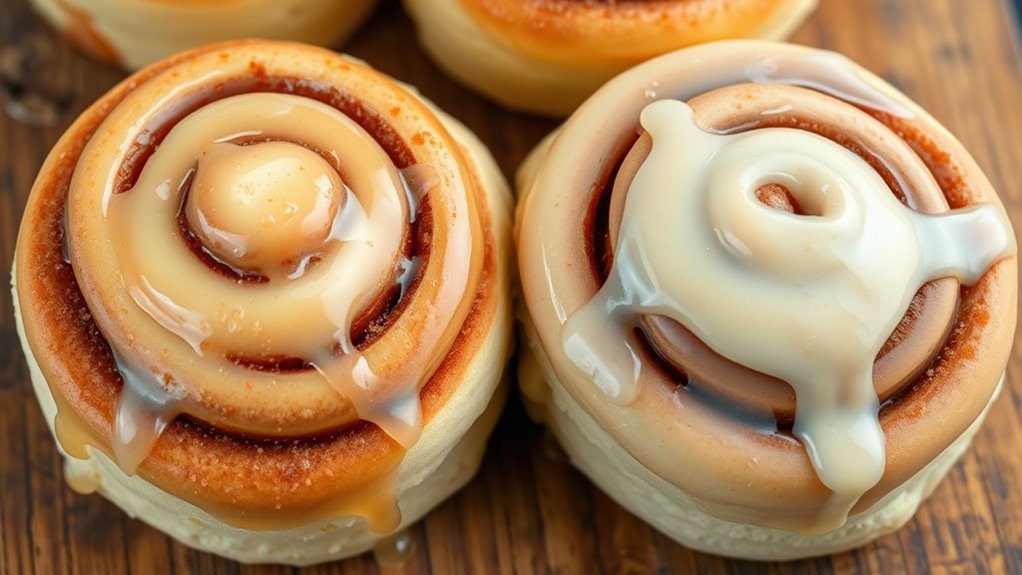
While both sweet butter and cultured butter add richness to cinnamon rolls, they bring distinct flavor profiles that can influence the overall taste. Sweet butter, made from cream directly from butter farming, offers a clean, delicate sweetness with subtle dairy notes. It’s minimally processed, preserving a fresh, creamy flavor. Cultured butter, on the other hand, undergoes a fermentation process during dairy processing, developing tangy, complex flavors with a slight acidity. This fermentation introduces depth and a faint sourness, which can enhance the warmth of cinnamon and sugar. Your choice impacts the final flavor; sweet butter provides a straightforward richness, while cultured butter adds a nuanced, tangy complexity that can elevate the overall taste of your cinnamon rolls. Additionally, safety features in heated mattress pads ensure they are safe to use, giving peace of mind during cozy nights.
The Role of Butter in Achieving the Perfect Cinnamon Roll Glaze
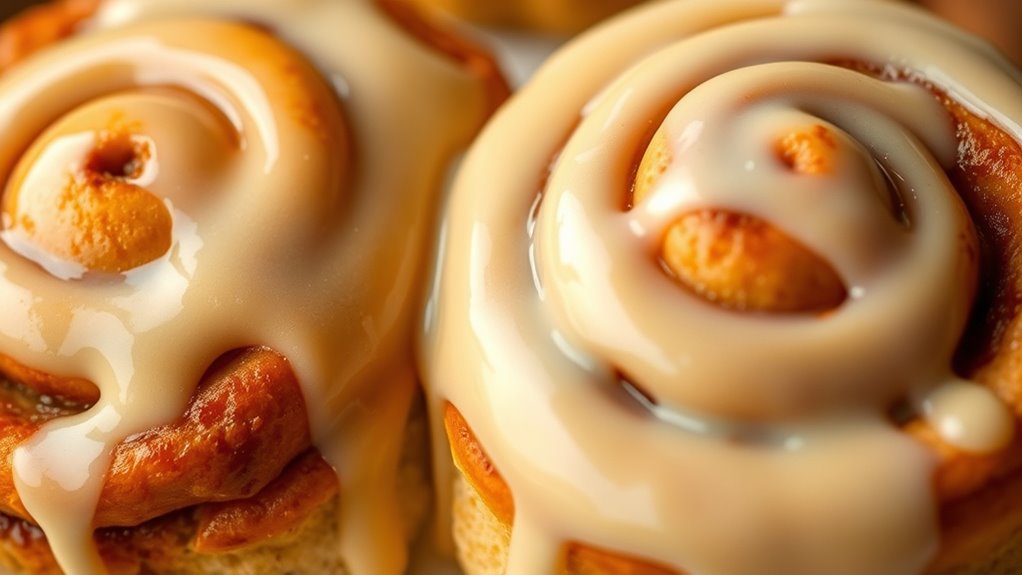
Achieving the perfect cinnamon roll glaze hinges on selecting the right butter, as it directly influences the glaze’s texture and flavor. Proper butter storage keeps it fresh, ensuring ideal flavor enhancement. When preparing your glaze, choose butter that’s at room temperature for smooth spreading and better incorporation. Cultured butter adds a tangy depth, while sweet butter offers a mellow richness—both impact the final result. To elevate your glaze, consider:
- Using fresh, well-stored butter to maximize flavor
- Adjusting butter quantity for desired thickness
- Incorporating a touch of vanilla or cinnamon for extra aroma
The butter’s quality determines whether your glaze is silky and flavorful or dull and lacking. Pay attention to storage, balance, and flavor enhancements to achieve that perfect sweet glaze every time.
Baking Performance: Melting, Spreading, and Incorporation
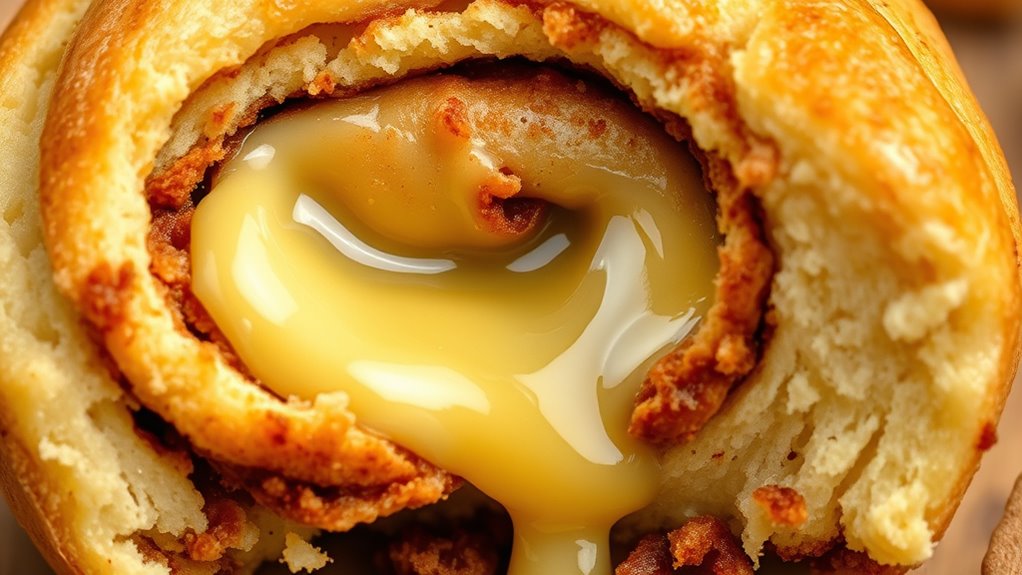
When baking with different butters, you’ll notice variations in how quickly they melt and spread in your dough. Cultured butter tends to melt slower, giving you more control, while sweet butter melts rapidly, which can affect spreading and incorporation. Understanding these differences helps you achieve the perfect texture and consistency in your cinnamon rolls.
Melting Speed Differences
The melting speed of butter considerably affects how it behaves during baking, especially in cinnamon rolls. Softer, warmer butter melts quickly, spreading evenly and blending smoothly into the dough. In contrast, colder or more solid butter melts slowly, which can cause uneven distribution. Your butter’s storage method and shelf life influence its melting properties: butter stored at room temperature melts faster, while refrigerated butter takes longer. Cultured butter, with its higher moisture content, tends to melt quicker than sweet butter. Vetted – 1st Home Theatre Projector Proper butter storage ensures consistent melting behavior for reliable results.
Spreadability in Dough
The way butter spreads within dough directly impacts the texture and appearance of your cinnamon rolls. Butter sourcing plays a key role here; high-quality, well-chilled butter tends to spread more evenly, creating a tender crumb. Cultured butter often has a slightly softer consistency due to its higher moisture content, making it easier to incorporate into dough. Conversely, sweet butter with lower moisture might require more effort to spread evenly. Packaging options also influence spreadability—individually wrapped sticks or resealable containers help maintain freshness and consistent temperature, ensuring consistent spreading. Properly sourced and packaged butter allows you to achieve a uniform distribution, preventing uneven pockets of butter that can affect the final texture. Additionally, understanding fetal development during pregnancy ensures you select the best ingredients for optimal results. Mastering spreadability ensures your cinnamon rolls are consistently soft, flaky, and beautifully layered.
Incorporation Ease
Incorporating butter into your cinnamon roll dough depends heavily on how easily it melts, spreads, and blends seamlessly with other ingredients. The way you store your butter affects this process—proper butter storage extends shelf life and maintains ideal melting qualities. For example, cultured butter, which often has a higher moisture content, tends to incorporate more smoothly, especially if it’s softened correctly. Sweet butter, with its lower moisture, may require a bit more effort to blend evenly. To make your mixing easier, consider these tips:
- Keep butter at room temperature for quick melting and easier incorporation
- Use fresh butter to ensure consistent melting performance
- Store butter properly to prevent spoilage that could hinder its melting and spreading abilities
- Butter storage methods can significantly influence its melting and incorporation qualities in baking
Pairing Butter Types With Different Cinnamon Roll Recipes

Choosing the right butter for your cinnamon rolls can considerably influence their flavor and texture, especially when pairing with different recipes. If you’re using a recipe with a rich, yeasted dough, cultured butter enhances depth through its butter fermentation process, adding a tangy complexity that complements the sweetness. For lighter, more delicate rolls, sweet butter’s clean, mild profile keeps the focus on the cinnamon and sugar. Dairy sourcing also plays a role; high-quality, locally sourced butter often provides fresher flavor and better consistency, regardless of type. Cultured butter’s fermentation process develops nuanced flavors, making it ideal for classic recipes, while sweet butter’s simplicity suits quick, everyday cinnamon rolls. Matching these butter types to your recipe’s richness and fermentation profile helps elevate your baking results.
Potential Health Benefits and Considerations of Each Butter
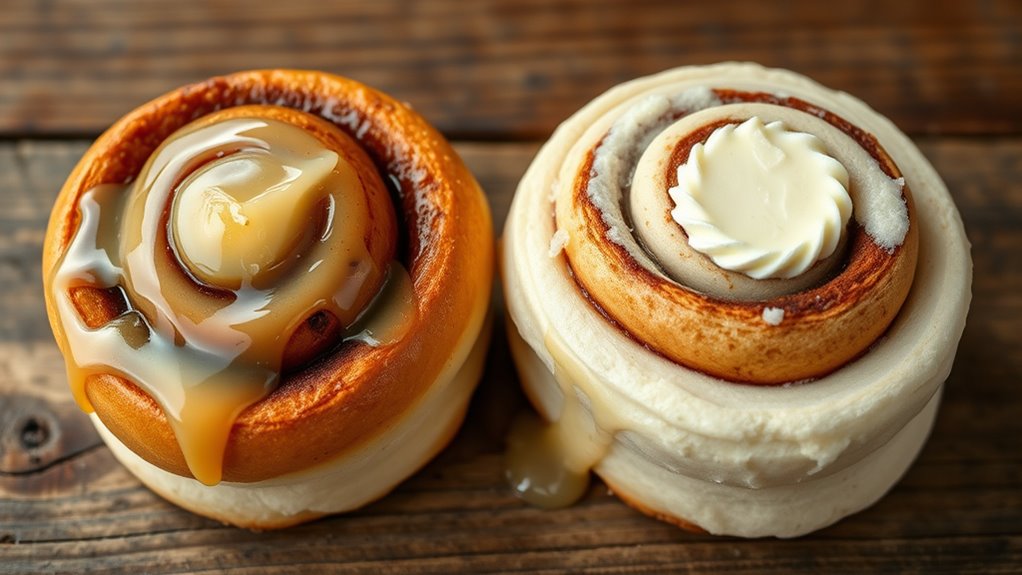
Both sweet and cultured butter offer distinct health considerations that can influence your choice. When it comes to butter nutrition and health implications, each type has unique benefits and drawbacks.
- Cultured butter contains probiotics that may support gut health, which is a plus if you’re mindful of digestion.
- Sweet butter is typically fresher and may have slightly fewer bacteria, but it lacks the added probiotics.
- Both types are high in saturated fats, so moderation is important for heart health.
- The fermentation process involved in cultured butter production can enhance flavor and potentially introduce beneficial bacteria, making it a more complex option.
While cultured butter might offer some digestive benefits, sweet butter’s simplicity means fewer processing concerns. Ultimately, your decision should weigh these health implications alongside taste preferences to choose the best butter for your cinnamon rolls.
Tips for Choosing the Right Butter for Your Cinnamon Rolls
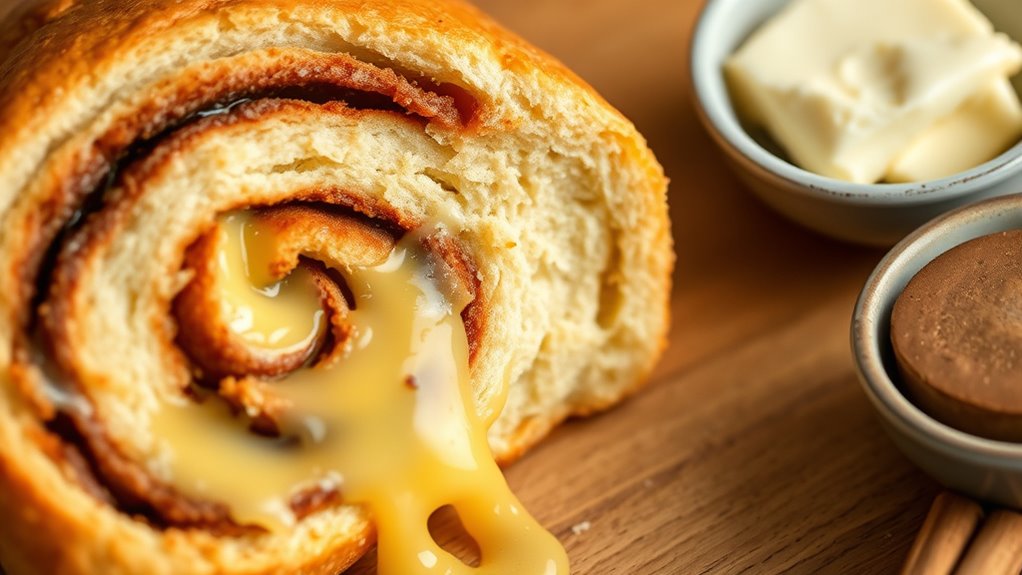
Selecting the right butter for your cinnamon rolls can make a noticeable difference in flavor and texture. First, consider butter storage—keep it chilled until use to maintain freshness and prevent spoilage. When shopping, decide if you want sweet or cultured butter; each brings unique qualities to your rolls. If a recipe calls for a specific type, stick to it for authentic flavor, but if you need a butter substitution, choose one with similar fat content and flavor profile. For richer, creamier rolls, cultured butter adds complexity, while sweet butter offers a milder, smoother taste. Remember, the quality of your butter impacts the final product, so opt for fresh, high-quality options to elevate your cinnamon rolls to perfection.
Frequently Asked Questions
How Does Butter Aging Affect Flavor Development in Cinnamon Rolls?
Butter aging influences flavor development in cinnamon rolls by intensifying its richness and complexity. As butter ages, it develops deeper, more nuanced flavors, which can enhance the overall taste of your rolls. Using aged butter adds a subtle tang and depth, creating a more layered, indulgent experience. You’ll notice that aged butter brings a richer aroma and a more complex flavor profile, elevating your cinnamon rolls to a new level of deliciousness.
Can Using Different Butter Types Alter the Cinnamon Roll’s Shelf Life?
Using different butter types can affect your cinnamon roll’s shelf life because of variations in melting points and salt content effects. Higher melting point butters stay firm longer, helping the rolls retain moisture and freshness. Salt content influences microbial growth, with more salt potentially extending shelf life. So, choosing a butter with the right melting point and salt level helps your cinnamon rolls stay delicious and fresh for a longer period.
What Are the Best Storage Practices for Butter Used in Baking?
Think of butter storage as guarding a treasure. To maximize shelf life, keep it in an airtight container in the fridge, ideally at or below 40°F. Avoid leaving it out at room temperature for long, as heat accelerates spoilage. For longer storage, you can freeze butter wrapped tightly. Proper butter storage preserves freshness and flavor, ensuring your baking ingredients stay at their best whenever you need them.
Are There Environmental Impacts Associated With Sweet and Cultured Butter Production?
You might wonder about the environmental impacts of sweet and cultured butter production. Both types come from dairy, but their environmental footprint varies. Cultured butter often uses sustainable dairy practices, reducing its impact, while sweet butter’s production can involve more energy and resources. Choosing sustainably sourced butter supports eco-friendly dairy farming, helping lessen your overall environmental footprint. Being mindful of your butter choices can make a positive difference for the planet.
How Do Regional Butter Varieties Influence Cinnamon Roll Flavor Profiles?
Regional dairy differences greatly influence butter flavor profiles, which can alter the taste of your cinnamon rolls. If you use butter from grass-fed cows in Europe, expect richer, more complex flavors. Conversely, locally produced butter with a milder profile may result in a subtler sweetness. These regional variations shape your rolls’ overall flavor, making each batch unique depending on where your butter comes from.
Conclusion
Choosing between sweet and cultured butter can transform your cinnamon rolls from good to legendary. Your butter selection influences flavor, texture, and overall baking magic — like the difference between a good story and a masterpiece. Trust your taste buds and experiment to find your perfect match, because with the right butter, your cinnamon rolls will be so irresistibly delicious, they’ll disappear faster than you can say “cinnamon wonder!” Happy baking!

